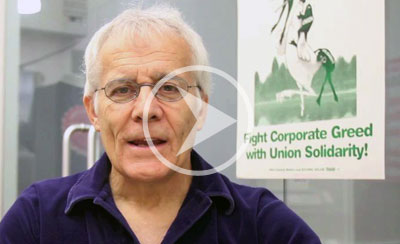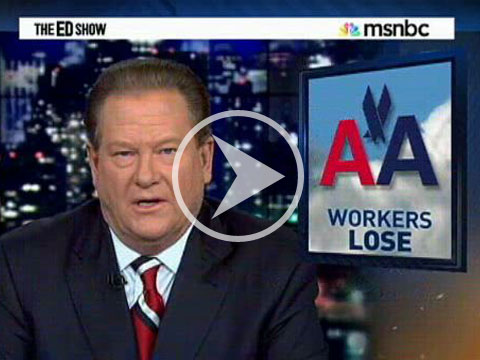What was APFA leadership thinking when they hired the Jefferies Group? (Part II)
Jefferies is an organization with ties close to AMR's interests, not with APFA's or organized labor
As a follow-up to last week's newsletter criticizing APFA 's hiring of the Jefferies Group to assist our union through the bankruptcy process, the following excerpts and subsequent article supports everything that the Salomon-Baust-Todd-Gillard slate has said thus far as to why we need to really fight back rather than simply accept what's coming.
As previously noted, Jefferies Group director, Peregrine Broadbent, and its general counsel/corporate secretary, Michael Sharp, have close ties to AMR through two of AMR's directors, Judith Rodin (Citigroup) and Phillip Purcell (Morgan Stanley). Now we learn from the following excerpt from "The corporate bankruptcy scam" by Sandy Boyer that Judge Sean Lane is also linked to Morgan Stanley through his former law firm. An excerpt:
"Sean H. Lane, the bankruptcy judge for American Airlines, which filed for Chapter 11 at the end of November, is a good example. He was a partner in the firm of Baker Hostetler, whose clients include companies like ExxonMobil, IBM, Morgan Stanley and ABC. Later, he was a top federal prosecutor, an assistant U.S. attorney for the southern district of New York."
Secondly, we've learned that the firm that AMR retained to assist AMR with their bankruptcy filing, Rothschild, has close ties to the Jefferies Group through one of their bankers. As the Wall Street Journal (July 5, 2011) notes: "Investment bank Rothschild is starting a North America equity-advisory practice and has hired Jefferies & Co. banker Matthew Sperling to run it...."
Thirdly, we've learned that the Jefferies Group hired a high level executive from Goldman Sachs. As you'll recall, Rajat Gupta, the director who was forced to resign from AMR's board this year over allegations of insider trading, was also a director for Goldman Sachs. Goldman Sachs is famous for their role in the subprime mortgage meltdown scandal that has left the U.S. economy is shambles. In short, Goldman Sachs firm sold securities backed by risky home loans while simultaneously betting that those bonds would lose value. The firm bears a great responsibility for the crisis we face today — fortunately for them the government bailed them out using taxpayer dollars.
Finally, there is a video as a part of an op-ed piece from The Labor Educator on what the unions should do in response to AMR's bankruptcy scam. The video highlights veteran labor strategist, Ray Rogers, who is also my second cousin.
In solidarity,
Rock Salomon
Candidate for APFA President
Salomon-Baust-Todd-Gillard
http://wewantourmoneyback.net
+++++++++++++++++++
The Corporate Bankruptcy Scam
By SANDY BOYER
The Indypendent
Sandy Boyer explains how big corporations like American Airlines are able to use bankruptcy laws to extract more concessions from union workers.
January 3, 2012
Bankruptcy may be a disaster for the 99 percent, but it can be a wondrous thing for million-dollar corporations.
Imagine, for a moment, that you're a corporate CEO, and you want to get rid of your union contract. Maybe you signed it at the height of the boom, and now it's beginning to pinch. While you're at it, maybe you'd like to stop the payments you agreed to make to that employee pension fund.
It's very simple — all you have to do is to file for corporate bankruptcy.
If you or I declare bankruptcy, we'll be lucky to hold onto a house, a car, our furniture and our clothes. Any bank account, any savings and any 401(k) account can be seized. It will be seven years before we can even get a credit card.
But everything is different for a corporation. They get to declare what is called "Section 11" bankruptcy. The company stops having to pay its bills. Often, it gets to adopt a plan to reduce its debts and go back into business as a "leaner," more profitable corporation.
One of the best ways to do this is to get rid of union contract. The judge overseeing a corporate bankruptcy can void anything he or she thinks would interfere with this plan for profitability.
The judge can even decide that a company can stop paying into its pension fund. Thus, any pension you thought you had coming is likely to be drastically cut. From now on, you probably won't even have a company pension plan. If you're 50 and thought you could retire on a pension at 65, forget about it.
The law makes it very clear that bankruptcy is about the needs of a company's creditors. Union contracts and the needs of workers don't really matter.
The decisions about voiding union contracts or cutting pensions are ultimately made by bankruptcy judges. So who are they and where do they come from?
To begin with, they make $160,000 a year. They are typically recruited from the top corporate law firms. Being a bankruptcy judge seems to be a nice, very prestigious, way to wrap up your legal career.
Sean H. Lane, the bankruptcy judge for American Airlines, which filed for Chapter 11 at the end of November, is a good example. He was a partner in the firm of Baker Hostetler, whose clients include companies like ExonnMobil, IBM, Morgan Stanley and ABC. Later, he was a top federal prosecutor, an assistant U.S. attorney for the southern district of New York.
It's no wonder that people coming from this kind of background interpreting this kind of law decide that corporate profits are much more important than workers' wages, working conditions or pensions.
American Airlines is the latest high-profile corporation to file for Chapter 11 bankruptcy.
But American is actually in fine financial condition. It had $4 billion in the bank when it declared bankruptcy. It stated that its cash on hand and the money it was making was more than enough to continue to pay off vendors and business partners on time and in full. It paid its top five executives $100 million in bonuses since 2005. In 2010, the top two executives made a combined $9 million.
The bankruptcy is all about forcing the American Airlines unions to accept wage and benefit cuts. Or, as the company's press release put it, to "address our cost structure, including labor costs."
We don't know the details yet, but it looks like American is going to target wages, working conditions and especially pensions.
The company is already backing out of recently negotiated contracts. It told the Transport Workers Union (TWU) it wouldn't finalize tentative agreements for 10,166 fleet service workers and 140 flight dispatchers. The company also stated that it wants changes in existing TWU contracts.
Management seems to be especially going after the pilots. The Fort Collins Republican Examiner reports, "American Airlines pilots will no longer have a pension plan as they knew it. They will also probably take yet another pay cut." The airline will demand that pilots fly more hours, according to a CNN report. That will translate into layoffs at a time when 600 pilots are still on furlough dating back to 2001.
American seems virtually certain to go after pensions. When American declared bankruptcy, its pension plans had about $8.3 billion in assets to cover about $18.5 billion in benefits. The day it filed for bankruptcy, it notified workers that future retirees can no longer get a lump-sum distribution because the pension plan is underfunded.
Reuters predicts that the airline will replace its pension plan with a self-funded 401(k) plan. Until now, American workers have had a 401(k) option, as well as their pension plan and a second defined contribution plan, which was funded by the plan company.
The Allied Pilots Association, which represents American's pilots, has indicated that it is willing to consider making concessions on productivity. Gregg Overman, the union's communications director, told CNN, "We have been open to taking a good look at that." Concessions on productivity are almost certain to mean layoffs.
Jim Little, president of the TWU, which represents mechanics and other ground workers, issued a statement saying, "Our union will fight like hell to make sure that front line workers don't pay an unfair price for management's failings." The TWU has hired a special bankruptcy lawyer. It has sent its attorney into bankruptcy court in Manhattan to defend workers' interests.
The union is absolutely right to explore all its legal options. But workers are likely to find that the legal deck has been stacked against them. Sooner or later, the unions may have to turn to industrial action, such as a work to rule, sickout or even a strike, if they want to save their jobs, working conditions and pensions.
American Airlines isn't the only company trying to use bankruptcy against workers. When Time magazine's Stephen Gandel examined bankruptcy data, he discovered that from 2003 onward, bankrupt companies have had an average of 6 percent more assets than liabilities, "meaning they were far from insolvent."
The United Auto Workers union, for one, has urged Congress to reform bankruptcy laws to stop companies from using them against workers. This is entirely reasonable -- but don't look for Obama or the Democrats in Congress to do anything about it anytime soon.
Ray Rogers of Corporate Campaign, Inc. talks about AMR's sham bankruptcy filing and what the unions should do.
***A message from Rock Salomon***
Bloomberg Law talks about how AMR practiced "venue shopping" to find a bankruptcy court that would be sympathetic to its needs.
Also, Ed Schultz of the Ed Show did a wonderful segment on AMR's bankruptcy filing and also questioned the math behind it. I urge everyone to watch it:















